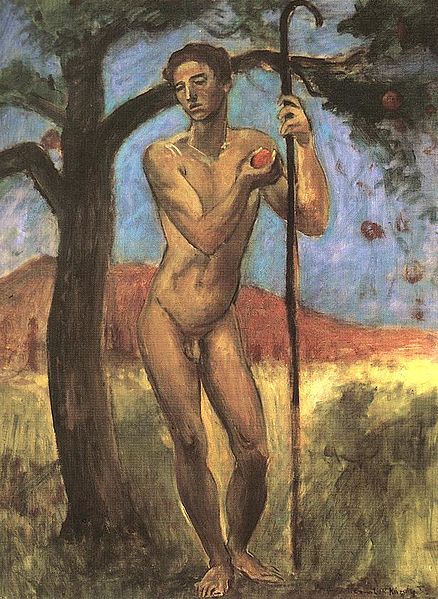File:Kernstok St John the Baptist 1932.jpg

Original file (616 × 842 pixels, file size: 126 KB, MIME type: image/jpeg)
Captions
Captions
Summary
[edit]| Károly Kernstok: St John the Baptist
( |
||||||||||||||||||||||||
|---|---|---|---|---|---|---|---|---|---|---|---|---|---|---|---|---|---|---|---|---|---|---|---|---|
| Artist |
artist QS:P170,Q556067 |
|||||||||||||||||||||||
| Title |
St John the Baptist |
|||||||||||||||||||||||
| Object type |
painting object_type QS:P31,Q3305213 |
|||||||||||||||||||||||
| Date |
1932 date QS:P571,+1932-00-00T00:00:00Z/9 |
|||||||||||||||||||||||
| Medium |
oil on canvas medium QS:P186,Q296955;P186,Q12321255,P518,Q861259 |
|||||||||||||||||||||||
| Dimensions |
height: 80 cm (31.4 in); width: 60.5 cm (23.8 in) dimensions QS:P2048,80U174728 dimensions QS:P2049,60.5U174728 |
|||||||||||||||||||||||
| Collection |
institution QS:P195,Q904812 |
|||||||||||||||||||||||
| Accession number |
89.38.1. |
|||||||||||||||||||||||
| Source/Photographer |
|
|||||||||||||||||||||||
| Permission (Reusing this file) |
|
|||||||||||||||||||||||
File history
Click on a date/time to view the file as it appeared at that time.
| Date/Time | Thumbnail | Dimensions | User | Comment | |
|---|---|---|---|---|---|
| current | 11:33, 3 March 2012 |  | 616 × 842 (126 KB) | Csanády (talk | contribs) | == {{int:filedesc}} == {{Artwork |artist={{Creator:Károly Kernstok}} |title={{LangSwitch |en=''St John the Baptist'' |hu=''Keresztelő Szent János'' }} |description= |date=1932 |medium={{Oil on canvas}} |dimensions={{Size|unit=cm|width=60.5|heigh... |
You cannot overwrite this file.
File usage on Commons
The following 3 pages use this file:
Metadata
This file contains additional information such as Exif metadata which may have been added by the digital camera, scanner, or software program used to create or digitize it. If the file has been modified from its original state, some details such as the timestamp may not fully reflect those of the original file. The timestamp is only as accurate as the clock in the camera, and it may be completely wrong.
| JPEG file comment | KERNSTOK Károly
(1873, Budapest - 1940, Budapest) Keresztelõ Szent János 1932 Olaj, vászon, 90 x 60 cm Deák gyûjtemény, Városi Képtár, Székesfehérvár Kernstok, a Nyolcak mûvészcsoport egyik vezetõ egyéniségének a tömeget és a szerkezetet kímélõ, monumentalitásra törekvõ mûvészete a két háború közötti idõszakra lehiggad, klasszicizálóvá és a meghatározó szerepet játszó posztnagybányai festészet hatására színesebbé válik. Ugyanez a folyamat játszódik le egész pályáját végigkísérõ férfiaktjain - Keresztelõ Szent János, 1909, Lovak a vízparton 1910 -, melyek 1926-os Berlinbõl való visszatérése után színesebbek, lágyabbak, klasszicizálóbbak lesznek (Keresztelõ Szent János, 1932, Ádám és Éva, 1935). Az 1932-ben festett figura jobb kezében almát tart, a baljában pedig pásztorbotot. A mögötte terebélyesedõ almafa a paradicsomra utal. A képet valami bukolikus hangulat lengi körül. A nyurga, túl hosszú törzsû fiú Matisse Táncának (1909-10) alakjaihoz hasonló. Erre emlékeztet a laza testtartás, a már említett megnyújtott idomok. Attribútumai közül viszont semmi sem utal Keresztelõ Jánosra, így nem is biztos, hogy ezt a bibliai személyt ábrázolja a mûvész. Mindenképpen rokona viszont az 1909-es Keresztelõ Szent János képnek, hiszen a két figura beállítása lényegében megegyezik. Az 1909-es mûvön egy könnyedén a keresztjére támaszkodó, s-alakban hajló, kontraposztos beállítású, igen hosszú kezû és lábú, karját a melle elõtt tartó fiút látunk. Ugyanilyen jelenik meg az 1932-ben készült festményen is, csak éppen a másik figurának a tükörképe: õ a jobb kezében tartja a pásztorbotot és a balt emeli (az almával) a mellé elé. E munkán már nem a rajzos kontúrok és a plasztikus formák, hanem a színek, a háttér kékje, a hegy barnás vöröse, a mezõ zöldje és sárgája dominálnak. Kernstoknál ez a kompozíciós megoldás nem csupán az itt bemutatott két esetben jelenik meg, hanem az 1911-es fának támaszkodó fiúaktján (Fiú), valamint az 1922-es fának dõlõ fiatalembert ábrázoló ceruzarajzán is. E képek szellemisége egy szebb és jobb világba, az aranykorba való vágyódást, az ember és a természet harmonikus kapcsolatát fejezi ki. Az 1932-ben készült Keresztelõ Szent János címû alkotás tehát egy korábbi 1910 körül megfogalmazódott filozófiai és festészeti ideálnak késõi megvalósulása. KERNSTOK, Károly (1873, Budapest - 1940, Budapest) St John the Baptist 1932 Oil on canvas, 90 x 60 cm Deák Collection, Municipal Gallery, Székesfehérvár The art of Kernstok, a major personality of the Eights, a group of artists, became classicizing and more colourful under the influence of the post-Nagybánya school, although it used to emphasize mass, structure and monumentality. The same applies to his male nudes which appear all through his oevre: "John, the Baptist", 1909, "House along the Water", 1910, which became more colourful, softer and more classicizing after his return from Berlin in 1926 ("John, the Baptist", 1932, "Adam and Eve", 1935). The figure of the picture painted in 1932 is holding an apple in the right and shephard's crook in the left. The apple-tree spreading behind it reflects Eden. The picture has a bucolic character. The long-legged boy with a much too long trunk is similar to figures of Matisse's "Dancer" (1909-10). The loose carriage and the extended shape of the body recall Matisse's picture. Of his attributes, however, nothing refers to "John, the Baptist", so Kernstok may not have portrayed the Biblical person. It seems to be linked to the 1909 version in pose which shows a boy who is gracefully leaning on his cross. His body is in an S-shape, and is arranged in counterpoise. He has very long legs and arms. The figure in the 1932 picture is almost the same, there being one difference: the later version appears as if reflected in a mirror, the figure here is holding the shephard's crook in the right hand and is raising the left with the apple in it. Sketchy contours and plastic forms no longer dominate the picture: colours, the blue of the background, the brownish red of the hill, the green and yellow of the field are more significant. This kind of arrangement does not appear only in the two pictures briefly described, but in the picture with a male nude leaning to a tree ("Boy") and in the 1922 charcoal-drawing. The picture expresses longing for a better and more beautiful world, a golden age, and the harmony of man and nature. The 1932 version of "John, the Baptist" realizes ideas of philosophy and art of 1910. Type: religious Time-line: 1901-1925 Form: painting |
|---|

